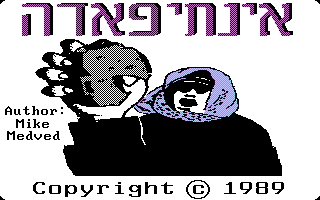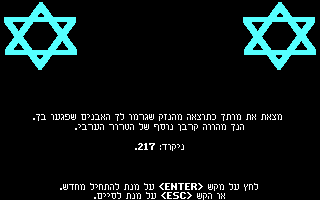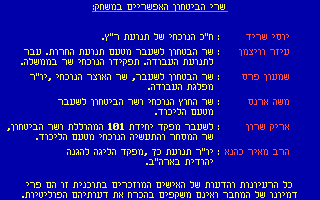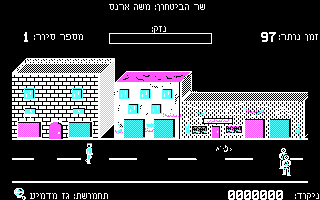Retro Replay Review
Gameplay
Intifada places you in the boots of an Israeli soldier on patrol during the First Intifada, tasking you with the delicate balance of quelling violent protests while minimizing casualties. The core loop revolves around strategic decision-making: choose between non-lethal methods like clubs, tear gas, rubber bullets, and increasingly severe options such as plastic bullets or live fire. Each tool feels distinct in its effect and risk, forcing players to constantly weigh the momentary ease of escalation against potential political fallout.
(HEY YOU!! We hope you enjoy! We try not to run ads. So basically, this is a very expensive hobby running this site. Please consider joining us for updates, forums, and more. Network w/ us to make some cash or friends while retro gaming, and you can win some free retro games for posting. Okay, carry on 👍)
Before each patrol, the game presents the current “open-fire policy” dictated by the defense minister, setting clear boundaries on which weapons you may employ against various protester threats. This policy layer adds tension, as missteps—firing too aggressively or holding fire too long—directly impact your success metrics. If you fail to neutralize enough protesters or cause excessive casualties, public support plummets, and the minister may be replaced, altering available tactics in subsequent missions.
The pacing is methodical rather than frenetic. You’ll spend significant stretches navigating narrow alleys, checkpoint chokepoints, and urban plazas while monitoring a situational HUD that flags incoming threats like Molotov cocktails or stone‐throwing crowds. Patrols can be tense, especially on higher difficulty settings where the line between non-lethal and lethal force blurs. Controls are straightforward, though the targeting system sometimes feels stiff during chaotic crowd engagements, requiring patience and deliberate aim.
Graphics
Visually, Intifada delivers a gritty, realistic depiction of West Bank towns in the late 1980s. Building facades show wear and bullet pockmarks, while debris-strewn streets and flickering street lamps evoke a tense atmosphere. Lighting and shadow work together to heighten suspense, especially during dusk or dawn missions when protesters can emerge from alleys with little warning.
Character models are surprisingly detailed for an indie title. Soldiers, protesters, and bystanders each have unique facial textures and body language—protesters clutch rocks or Molotov cocktails, while your squadmates call out orders in Hebrew. Animation quality shines during close-quarters arrests, gas canister throws, and rubber‐bullet volleys, though large crowd scenes sometimes exhibit clipping or repetitive movement loops.
Environmental variety helps prevent visual fatigue. You’ll patrol narrow backstreets, open junctions, construction-site shanties, and market stalls. Each locale introduces fresh tactical challenges—cover spots, chokepoints, and vantage points—while maintaining the game’s signature dusty, sun‐bleached color palette. Occasional texture pop-ins remind you of hardware limits, but overall the presentation feels cohesive and authentic.
Story
Intifada’s narrative framework is lean, driven primarily by mission briefings and ministerial directives rather than cutscenes or character arcs. You’re a faceless soldier executing orders, and the game uses minimal dialogue to emphasize your role as a policy enforcer rather than an individual hero. This design choice reinforces the impersonal nature of occupation and crowd control, though it may leave players craving deeper emotional connections.
Despite its sparse storytelling, the game evokes moral tension through mechanics. The minister’s changing open-fire policies serve as a narrative device, illustrating how public opinion and political power can reshape rules of engagement overnight. Each time the policy shifts—either tightening or loosening your force options—you feel the weight of a government entirely focused on maintaining order, regardless of human cost.
Supporting details emerge through environmental storytelling: graffiti scrawled on walls, discarded prayer mats, and personal items dropped during riots. These background touches hint at the strained lives of civilians caught in the conflict’s crossfire, offering emotional subtext that contrasts with your regimented patrol routine. While you won’t find lengthy dialogues or moral monologues, the game’s minimalism leaves space for players to reflect on the historic moment it portrays.
Overall Experience
Intifada is a thought-provoking tactical simulation wrapped in a controversial historical setting. Its strengths lie in the weight of every decision: opting for tear gas over rubber bullets, pausing to reassess targets, or pressing forward with live fire when directives allow. This constant negotiation between orders and ethics creates a distinctive sense of responsibility rarely seen in shooter titles.
However, the game’s deliberate pace and moral ambiguity won’t appeal to everyone. Players seeking high-octane action or clear-cut hero narratives may find themselves frustrated by the strict policy constraints and the sobering context. Casual gamers might also struggle with the steeper learning curve and the emotionally heavy subject matter that underpins each mission.
For those interested in exploring the intersection of tactics, politics, and history, Intifada offers an immersive, challenging experience. Its combination of responsive gameplay systems, authentic visuals, and minimalist storytelling may spark debate long after you complete the final patrol. If you’re ready for a game that demands both strategic skill and ethical reflection, Intifada is a unique entry to consider.
 Retro Replay Retro Replay gaming reviews, news, emulation, geek stuff and more!
Retro Replay Retro Replay gaming reviews, news, emulation, geek stuff and more!








Reviews
There are no reviews yet.